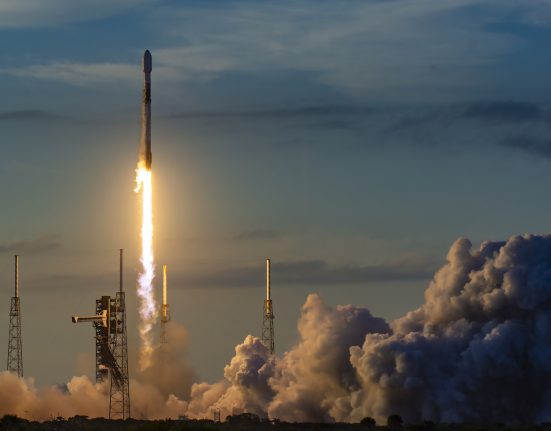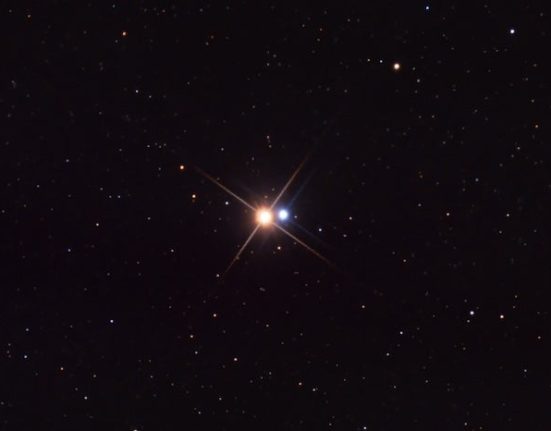
Update 8:19 p.m. EDT: SpaceX canceled a launch opportunity Tuesday morning and will move to a 24-hour backup window on Wednesday, Aug. 28.
A historic commercial astronaut mission will launch before dawn Wednesday morning. The four members of the Polaris Dawn flight will board SpaceX's Crew Dragon to embark on a roughly five-day free-flight mission in orbit around Earth.
The crew, led by billionaire entrepreneur Jared Isaacman, will go farther than humans have ventured since the conclusion of the Apollo missions more than 50 years ago. They will also conduct the first commercial spacewalk in history.
SpaceX had originally planned to launch the mission on Tuesday morning, but opted to delay the mission's launch by 24 hours. The rocket descended to a horizontal position around 5 p.m. EDT (2100 UTC) on Monday for “additional pre-launch checks.”
After 8 p.m. EDT, the company said: “Teams are taking a closer look at a helium leak in the quick disconnect umbilical. Falcon and Dragon remain in good condition and the crew remains ready for their multi-day mission in low Earth orbit.”
While it is unfortunate not to be participating in a launch attempt tonight, I am very proud of the team for identifying a problem and then resolving it. Nothing is more important than the safety of our astronauts and the reliability of our vehicles and operations. https://t.co/hBOeYOCUm0
— Kiko Dontchev (@TurkeyBeaver) August 27, 2024
Isaacman is joined on the flight by pilot Scott “Kidd” Poteet, mission specialist and medical officer Anna Menon and mission specialist Sarah Gillis. Menon and Gillis will become the first female SpaceX employees to travel to space.
Liftoff of the Falcon 9 rocket supporting this mission from Launch Complex 39A is scheduled for 3:38 a.m. EDT (0738 UTC). If needed, SpaceX has two additional launch opportunities within Wednesday's window at 5:23 a.m. EDT (0923 UTC) and 7:09 a.m. EDT (1109 UTC).
Spaceflight Now will have live coverage of the mission beginning approximately 4 hours before liftoff.
Menon, who writes a journal often, said she hopes to be able to recount this trip for more than just her own memories.
“I try hard to capture a number of things. Especially as we get closer to flight, this has been really obvious, time is fast, it’s flying by, and our days are action-packed leading up to the mission, but especially leading up to launch,” Menon told Spaceflight Now in July. “I try to jot down the details because I know one day I’ll look back and I suspect it will be pretty blurry. I try to jot down the details so that one day I can look back on them and remember all the nuances of this experience.”
“But I also try to capture my feelings and the experiences I’m having with my crewmates and this fantastic team at SpaceX to not only transport me back to the technical details, but also the emotions of going through this.”
Polaris Dawn will be Isaacman’s second time in space and the second time the Shift4 Payments CEO has served as mission commander aboard a Crew Dragon spacecraft. Isaacman will also become the second person to fly aboard a Dragon twice, following Axiom Space astronaut Michael López-Alegría’s second flight on Axiom Mission 3 (Ax-3) earlier this year.
“It takes a massive team effort to make a mission like Polaris Dawn a reality. Together, we are making incredible progress for the future, both in space and here on Earth,” Isaacman wrote in a social media post following the conclusion of the mission readiness review Monday morning. “We can do both.”
It takes a huge team effort to make a mission like Polaris Dawn a reality. Together, we are making incredible progress for the future, both in space and here on Earth.
We can do both. https://t.co/iOuBuTFJHG
– Jared Isaacman (@rookisaacman) August 26, 2024
The Falcon 9 rocket supporting the mission, with tail number B1083 in SpaceX’s fleet, will launch for the fourth time on this flight. It previously supported the Crew-8 mission to the International Space Station, as well as sending two batches of SpaceX’s Starlink internet satellites into low-Earth orbit.
With the Crew Dragon spacecraft atop, the launch vehicle reaches a height of 65 m (213.3 ft). Dubbed Resilience, Dragon will make its third trip to space after launching both the Crew-1 mission and Inspiration4, Isaacman's first trip beyond Earth.
Because Resilience will launch into a 190 x 1,200 km (118 x 746 mi) orbit at a 51.6-degree inclination, B1083 will land on SpaceX's uncrewed craft, A Shortfall of Gravitas, approximately 9.5 minutes after liftoff.
“He @PolarisProgram “Mission Readiness Review just completed and we are currently ready to launch in just over 24 hours,” SpaceX founder Elon Musk wrote in a social media post. “Crew safety is absolutely paramount and this mission carries more risk than usual as it will be the furthest distance humans have traveled since the Apollo mission and the first commercial spacewalk.”
“If any concerns arise, the launch will be postponed until the concerns are resolved.”
He @PolarisProgram The mission readiness review has just been completed and we are currently ready for launch in just over 24 hours.
The safety of the crew is absolutely paramount and this mission carries more risks than usual, as it will be the farthest journey humans have made from Earth since Apollo and… https://t.co/4TEwupwldQ
— Elon Musk (@elonmusk) August 26, 2024
Record distance
During the first day of flight, the rocket will reach its apogee (the highest point in its orbit) of up to 1,400 kilometers. At that distance, the Polaris Dawn crew will have flown farther from Earth than any human being since the end of the Apollo 17 mission in 1972.
“When you go into this environment, you’re dealing with totally different realities than, say, going to the space station,” Isaacman said at a prelaunch briefing. “It’s a lot of energy going into the vehicle, it’s a lot of energy that you have to get out of the vehicle when you get back home. It’s a different radiation environment. It’s a different micrometeorite orbital debris environment.
“This way, we can learn a lot in terms of human health, science and research. If we ever get to Mars, we would love to be able to come back and be healthy enough to tell people about it.”

The distance will also give Gillis and Menon the honor of being the women who have traveled the farthest from Earth to date. NASA astronaut Christina Koch will break that record when the Artemis 2 mission launches for a trip around the Moon no earlier than September 2025.
Gillis joined SpaceX as the company was honing its human spaceflight program ahead of the Demo-2 mission in May 2020, crewed by former NASA astronauts Robert Behnken and Doug Hurley. He said being part of the mission to prepare Dragon to withstand impacts from the Van Allen radiation belts and for the first commercial spacewalk has been a great coming-full-circle moment.
“It’s been really cool to be able to start that process over again over the last two years, like it’s a different development program, where we’re adding a full nitrogen repression system to the spacecraft. We have to make sure that there are the appropriate mobility aids to help a crew member perform the EVA,” Gillis said. “It’s been really cool and really special to me, given my background on why the Dragon is the way it is, but now to be able to help develop a completely new spacesuit and test how it integrates into the spacecraft and how it can actually support a spacewalk.
“So it’s been really cool for me to be involved in this over the last two years.”
Spacewalking on Skywalker
The highlight of the mission for many people, both within SpaceX and the Polaris Program and beyond, will be the spacewalk that will take place on the third day of flight.
Because Crew Dragon has no airlock, the entire vehicle will lower itself to create a vacuum during the spacewalk. Isaacman and Walker will physically exit the Dragon capsule, one at a time, with the help of a handrail and foot rail system, called a “Skywalker.”
The homage to the “Star Wars” franchise follows the name of the rocket itself, the Falcon 9, which is a nod to the Millennium Falcon, seen throughout the films.
Much of the training over the past two and a half years has involved working on pre-breathing protocols to purge nitrogen from their systems. The process will begin about an hour after they reach orbit and continue slowly over a couple of days before the third day of flight arrives.

“This pre-breath is designed to help mitigate the risk of decompression sickness when we evacuate inside the spacesuits,” Gillis said. “Over the course of approximately 45 hours, we will slowly reduce the cabin pressure and increase the oxygen concentration to help mitigate the risk.”
The spacewalk will last about two hours and SpaceX intends to livestream the event using the various cameras positioned around the Dragon spacecraft. Gillis, who trains astronauts on working with the capsule and spacesuits, said she is eager to test them in orbit.
“I think the most interesting thing is what that looks like in space. It’s end to end. You know, we start from the design concept all the way to the actual experience in orbit. So I’m very, very interested to see what we learn from the EVA, how we need to modify our training for future spacewalks,” Gillis said. “But it should be really interesting to see how that whole evolution of the design plays out.”
Poteet said the training he and his crewmates experienced with SpaceX equipment gives him great confidence in the mission ahead.
“Spending thousands of hours in the simulator helped us gain confidence to handle any scenario Melissa decided to throw at us,” Poteet said, referring to one of SpaceX’s instructors. “It was a big challenge … but experiencing those scenarios and trying to identify what’s wrong and then how we work together to solve those problems certainly gave us confidence to be able to handle those very low probability scenarios in orbit.”













Leave feedback about this